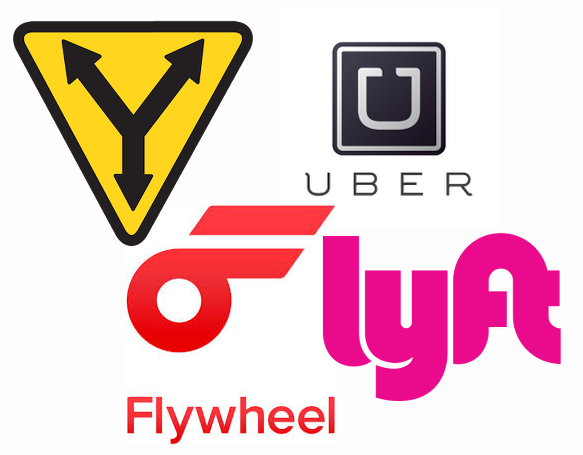By: Jim Schrempp | Posted: January 4, 2016 | Updated: March 22, 2023
This analysis is the more detailed comparison of rideshare apps that we used to make our recommendations in the companion article entitled “Get a Ride Anywhere: New Options for Older Adults”.
In this work we set out to find the best rideshare app for older adults. We looked at Uber and Lyft primarily, but also considered Flywheel, the taxi summoning app.
Rideshare App Alternatives
The two dominant rideshare app players are Uber and Lyft. They both do essentially the same thing, but there are a few differences. This article will discuss them both as well as others. Our analysis is based on our own use of these two services, as well as information we have gathered from a number of places on the web. We’ve synthesized all this data into some key information for you.
What They Do
Both Uber and Lyft provide a market place for drivers to meet passengers. Drivers are often part-timers. The services perform background checks, DMV checks, and provide insurance to cover passengers in the case of an accident. The drivers use their own cars, and both companies require that the drivers maintain their car in good shape, and clean it often. The differences are small; in fact, many drivers work for both Lyft and Uber, taking whatever assignments are available.
To use one of these services you download their app onto your smart phone and create an account. When you want a ride you start the app and it uses GPS to find your exact location. The app will display a map of your area with each of the drivers in your local area shown with a little car; the app will tell you how long it will take for the nearest driver to reach you. “Get a ride in 4 minutes,” it might say.
You tap in the destination address and tap “get me a ride”. The rideshare app contacts all available drivers in your area, assigns one, and gives you an updated arrival time. It will show a little photo of your driver, the car, and something like “Tim will be there in 6 minutes.” At this point you can tap the “cancel ride” button if you’ve made a mistake; you won’t be charged if you do this within a minute of scheduling the ride.
The location of your assigned driver appears on the map and you can watch as the car gets closer and closer to you. When you see them pull up to your location, you get in, just like a taxi.
The driver will use his own smart phone mapping system to follow directions to your destination. Once there you tap on the app to say that the ride is over. You get out and the app automatically charges your credit card and pays the driver. The price is based on distance, time, and a starting base fee. This can vary by location but is typically $1 to start, $1.50 a mile, and $0.25 per minute of travel time. There are a few other standard fees that might add $2 to the ride. If you cross a toll bridge that is also added to the bill. Overall the price of a ride is usually 10-20% less than a similar ride in a taxi.
One important difference over a normal taxi is that both these apps have “premium” rate periods. During busy times the price of a ride is doubled – or more! Both apps make this very clear when you request a ride, so you won’t be surprised with a big bill. If you want a ride to lunch on Tuesday, you’ll pay the standard rate. Getting home from church at 10am on Sunday might cost you double or triple the normal rate. If the app tells you this is a premium rate time, you can always wait; have another cup of coffee and try again in 20 minutes.
After the fact, you can rate your driver on a scale of 1 to 5 stars. Drivers who average less than 4.5 stars are fired and don’t get to drive again. Don’t give your driver 3-stars unless you really think the service was poor. 5 stars should be your normal rating unless there was some problem – dirty car, surly driver, bad driving habits.
At the same time, the driver has a chance to rate you as a passenger. Passengers who average less than 4 stars are not allowed to use the service. So don’t be abusive to your driver, don’t yell at him, and don’t throw up on his back seat!
All this rating back and forth might seem odd, but it’s proven to be a good way to keep everyone civil and polite.
Do They Work Everywhere?
Yes, and no. Uber and Lyft are coordinating networks of local drivers. In some areas there are lots of drivers available, in other areas not so many. Also, drivers do not work assigned shifts; individual drivers can take themselves out of service when they have something else to do. During a big football game many drivers might prefer to watch the game instead of drive. But that might trigger the service to declare a “premium rate” period and the higher rates might bring some drivers back into service. It could be an example of supply and demand working out the best market price. One study of Uber found that there were actually fewer drivers available during premium rate periods. We have to conclude that at this time the process is still evolving.
In our testing there were always drivers available in San Francisco. In the bigger suburbs outside the city there were almost always drivers available. In some of the much smaller suburbs the availability of drivers depended on the time of day.
The only way to know for sure is to get the apps on your smart phone and start them up. You can quickly see on the map in the app if there are any drivers in your area. If you have both Uber and Lyft on your smart phone then if one service has no nearby drivers, you can check the other service. If sometime you find there are no drivers available, wait 30 minutes and check again – these networks are dynamic. And remember, this is still better than standing on a street corner hoping that an empty cab will come by.
Special Services
Both Uber and Lyft offer a few different services. We’ve been describing their low end services called UberX and Lyft, where drivers use their own sedans to give you a ride.
Both services offer a “higher class” service: Uber Black Car and Lyft Plus. These services use bigger, typically black cars in the class of a Lincoln Towncar. You pay more, but the ride feels more like a limousine service. There is often a longer wait to get a ride in this class.
Both services are experimenting with rides that cater to a person with limited mobility. Uber Access provides additional help getting in and out of the vehicle and the driver will fold up a wheelchair to put in the trunk. In some locations they offer Wheelchair Accessible Vehicles (WAV). These services are offered in fewer locations and can have an even longer wait to get a ride. We did not have enough experience with these services to render an opinion.
A Word about Surge or Premium Pricing
As mentioned above, both Uber and Lyft will charge more for a ride during peak usage times. They call this “surge” or “premium” pricing. In a more traditional taxi business there might be a surcharge during certain times of the week. However with Uber and Lyft these premium times are determined on the spur of the moment. Both applications will warn you if you arrange a ride during a premium time period – this isn’t a hidden charge.
Premium pricing can change every five minutes. If the app alerts you to premium pricing, you might wait 10 minutes and try again.
Premium pricing is also set by geographic area. If you are in a big city, you could try walking two or three blocks away from the downtown area, or a nearby venue (sports arena, opera house, civic center). Sometimes walking a few blocks will put you into a different geographic service area, one that is not experiencing premium pricing.
Why do they use premium pricing? The theory is that when the higher premium price is active, then more drivers will come on duty and thus meet the demand. While the theory sounds good, an investigation shows that it does not always work.
http://www.propublica.org/article/uber-surge-pricing-may-not-lead-to-a-surge-in-drivers
Uber or Lyft?
The two services are really very similar. Some areas have more Uber drivers available and some have more Lyft drivers. Many users of these services have both on their smart phones. They first try their favorite app and use the other if the first has no drivers available at the time.
Why Uber?
Uber is the larger of the two networks and may have more drivers in your area. The UberX driver is probably wearing a neat collared shirt and slacks – what is now called “business casual dress.” When the UberX driver arrives he will get out to open your door. You sit in the back seat. The driver is likely to be more stoic and the ride will feel professional.
The Uber app has a feature to estimate the price of your trip before you book it. This is a nice feature, but the price is not a guarantee, just an estimated range.
As you drive to your destination the Uber app will show you the accumulating price, much as a taxi meter shows the ever increasing cost. Once at the destination Uber does not allow you to tip your driver. Some passengers hand the driver a few dollars, but most just step out and leave it at that.
Why Lyft?
Lyft’s motto is “your friend with a car” and that really sums up their approach to the business. Your Lyft driver may be wearing jeans and a t-shirt and maybe a funky hat. He probably won’t get out to open the door for you, but he will help with your luggage or grocery bags. He’ll offer to let you sit up front in the passenger seat. If you want, he’ll even have a conversation while you two drive to your destination. Or “she”; it’s reported that Lyft has more women drivers than UberX.
This casual attitude doesn’t mean the drivers are any less competent than UberX drivers. In fact, Lyft puts their would-be drivers through a special “mentor interview” to make sure they have a friendly, outgoing personality.
The Lyft app only provides price estimates in a few locations, New York City is one. We don’t think this is a big drawback. The rates are set by Lyft, not the drivers, and they seem fair. Most times when you get in a taxi you don’t know what the total price will be until you reach your destination; this is the same with both Lyft and UberX. Once you take your first ride you’ll feel more comfortable about the price.
After you get out of your Lyft ride, the app will allow you to add a tip for the driver. The app will show buttons for 0%, 10%, 15%, 20% or let you put in a precise dollar amount. A tip is not required, but if you do tip it all goes to the driver – Lyft does not keep any of the tip.
Best Rideshare App for Older Adults
Of the two rideshare app alternatives we have mainly focused on in this article, Lyft and Uber, our Longevity Explorers (circles of older adults) have tended to feel most comfortable with Uber. It seems the general approach and more conventional demeanor of the service and drivers is the better fit of these two services to most of our older adult explorers. A number of the older adults in our Longevity Explorer circles have now tried Uber and reported rather enthusiastically back about its convenience and cost compared to other transportation alternatives they have.
It should be said however that a sizable minority of our explorers feel uncomfortable with the whole idea of rideshare services that are not taxis. For those older adults, Flywheel is the obvious alternative (see below).
Rate Your Ride
While we discussed this earlier, it is worth a second mention. After you end your ride the app will ask you to rate your experience on a scale of 1 to 5. Many people feel that a normal, “good” ride should get 3 stars; they only want to give a rating of 5 for an exceptional experience. This is NOT how Uber and Lyft work. We are led to believe that a driver who gets ratings of 3 stars will be dropped from the network.
If you have a bad ride, then by all means let it show in your rating. However, if the ride meets your expectation and you think the driver should be able to keep driving, then give a 5 star rating.
What Do I Do Now?
Take a ride! We recommend that you download both Uber and Lyft apps to your smart phone. Start each and create an account on each. Then pick a nearby location – a friend’s house or a local supermarket. Open one of the apps and take a ride. Once you take one ride we think you’ll be hooked.
What about Flywheel?
This whole article is about a new way to summon a ride from a network of drivers. It’s very friendly to use an app to do this. Seeing a photo of your driver and his current GPS location is reassuring (How often has a taxi service told you “the driver will be there in 15 minutes” but it took an hour for him to show up?). There’s no reason that traditional taxi services can’t provide the same service. Flywheel is a company that tries to do just that.
Flywheel works like Uber and Lyft, but a real, licensed taxi cab will come to pick you up. In fact, San Francisco’s oldest cab company, DeSoto, has rebranded all their cabs as Flywheel cabs.
It all sounds good, however, in our testing we had mixed experience in San Francisco. In some areas of the city we found that Flywheel seemed to never have a cab available. At the same time UberX and Lyft would show many drivers near-by. On the other hand, one of our testers in another part of San Francisco preferred Flywheel. He found that there were always cabs available in his area and he became frustrated with Uber and Lyft drivers who were not familiar with the streets of the city and relied on their GPS for directions. This tester calls himself “a bit of a curmudgeon” and likes traditional taxi services. Yet even this tester was won over to Uber on a trip to a Midwest city that didn’t have Flywheel service.
Our conclusion: If you want to take a taxi, call your local cab company on the phone.
To Sum It All Up
Lyft and Uber are two very similar services that can get you from where you are to where you want to be – and bring you back again. If you can’t drive, or don’t want to, these apps offer a unique value over traditional taxi services. They are often faster to arrive and significantly cheaper than a taxi.
This is yet another area where the internet and smart phones has created a new business model where none existed before. In this case it brings a new value to us, the consumer.
Things to Remember
Lyft
- Corporate Culture: Relaxed, friendly.
- Prime Time: Up to 3x normal rate.
Uber
- Corporate Culture: Stoic, professional.
- Prime Time: Up to 8x normal rate.
Your area
Each app has a map of your area with available drivers shown. Check it out for your home location.
How to download, set up, and use Uber. See the videos we prepared.
Want More Like This?
*Disclosure: The research and opinions in this article are those of the author, and may or may not reflect the official views of Tech-enhanced Life.
If you use the links on this website when you buy products we write about, we may earn commissions from qualifying purchases as an Amazon Associate or other affiliate program participant. This does not affect the price you pay. We use the (modest) income to help fund our research.
In some cases, when we evaluate products and services, we ask the vendor to loan us the products we review (so we don’t need to buy them). Beyond the above, Tech-enhanced Life has no financial interest in any products or services discussed here, and this article is not sponsored by the vendor or any third party. See How we Fund our Work.



Boy do you need to update
Boy do you need to update this article…
UberX drivers do not
UberX drivers do not typically wear business casual, and will most never hop out to open your door.